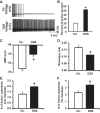Genesis of anxiety, depression, and ongoing abdominal discomfort in ulcerative colitis-like colon inflammation
- PMID: 25411361
- PMCID: PMC4281679
- DOI: 10.1152/ajpregu.00298.2014
Genesis of anxiety, depression, and ongoing abdominal discomfort in ulcerative colitis-like colon inflammation
Abstract
Psychological disorders are prevalent in patients with inflammatory bowel disease; the underlying mechanisms remain unknown. We tested the hypothesis that ulcerative colitis-like inflammation induced by dextran sodium sulfate (DSS) exacerbates the ongoing spontaneous activity in colon-projecting afferent neurons that induces abdominal discomfort and anxiety, and depressive-like behaviors in rats. In this study, we used the conditioned place preference and standard tests for anxiety- and depression-like behaviors. DSS rats developed anxiety- and depression-like behaviors 10 to 20 days after the start of inflammation. Single-fiber recordings showed an increase in the frequency of spontaneous activity in L6-S1 dorsal root ganglion (DRG) roots. Prolonged desensitization of transient receptor potential vanilloid 1 (TRPV1)-expressing colonic afferents by resiniferatoxin (RTX) suppressed the spontaneous activity, as well as the anxiety- and depressive-like behaviors. Reduction in spontaneous activity in colon afferents by intracolonic administration of lidocaine produced robust conditioned place preference (CPP) in DSS rats, but not in control rats. Patch-clamp studies demonstrated a significant decrease in the resting membrane potential, lower rheobase, and sensitization of colon-projecting L6-S1 DRG neurons to generate trains of action potentials in response to current injection in DSS rats. DSS inflammation upregulated the mRNA levels of transient receptor potential ankyrin 1 and TRPV1 channels and downregulated that of Kv1.1 and Kv1.4 channels. Ulcerative colitis-like inflammation in rats induces anxiety- and depression-like behaviors, as well as ongoing abdominal discomfort by exacerbating the spontaneous activity in the colon-projecting afferent neurons. Alterations in the expression of voltage- and ligand-gated channels are associated with the induction of mood disorders following colon inflammation.
Keywords: anxiety; depression; inflammatory bowel disease; spontaneous activity in visceral afferent neurons; visceral hypersensitivity.
Copyright © 2015 the American Physiological Society.
Figures







References
-
- Addolorato G, Capristo E, Stefanini GF, Gasbarrini G. Inflammatory bowel disease: a study of the association between anxiety and depression, physical morbidity, and nutritional status. Scand J Gastroenterol 32: 1013–1021, 1997. - PubMed
Publication types
MeSH terms
Substances
Grants and funding
LinkOut - more resources
Full Text Sources
Other Literature Sources
Medical

